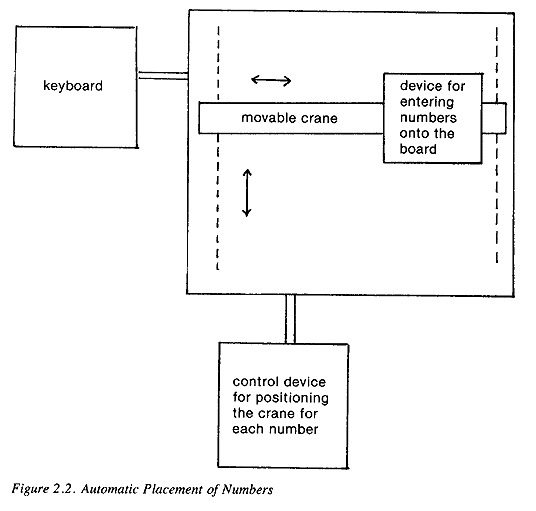| Reckoners, Germany, page 0010 |
2
Computers in Germany
Computers in Germany
| . |
|
| Reckoners, Germany, page 0011 |
| Reckoners, Germany, page 0012 |
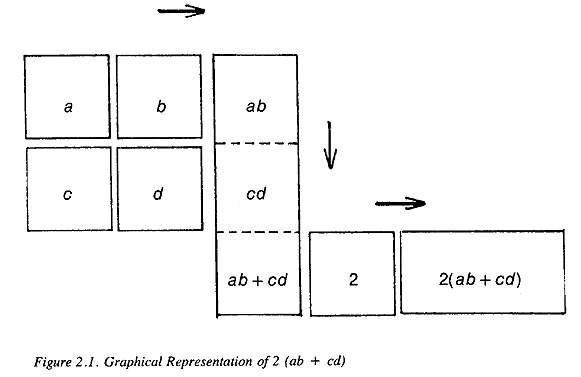
| Reckoners, Germany, page 0013 |
| Reckoners, Germany, page 0014 |
| Reckoners, Germany, page 0015 |
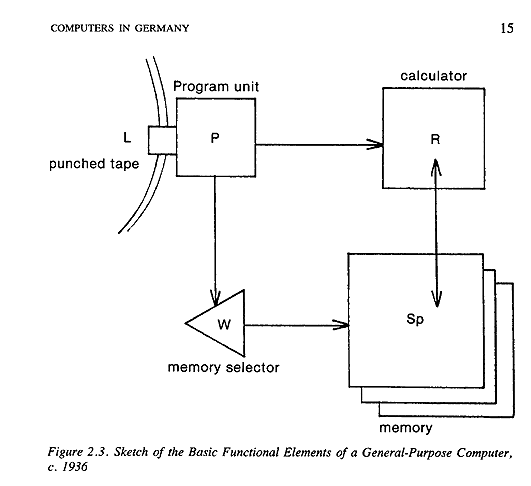
| Reckoners, Germany, page 0016 |
MECHANICAL CALCULATION, c. 1935
It was here that the machinery was most likely to jam.
| Reckoners, Germany, page 0017 |
THE PATH TO THE FIRST COMPUTER
| Reckoners, Germany, page 0018 |
| Reckoners, Germany, page 0019 |
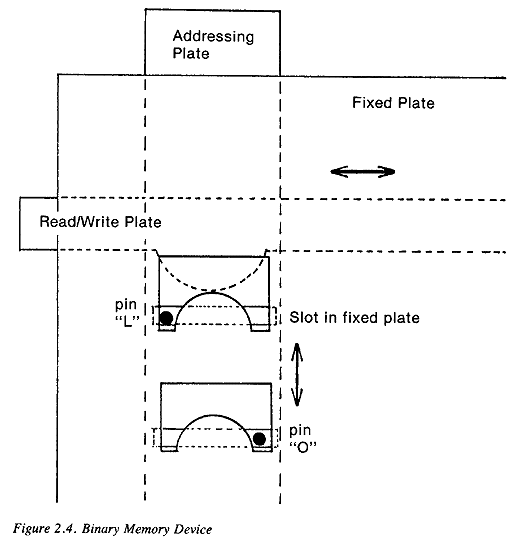
| Reckoners, Germany, page 0020 |

| Reckoners, Germany, page 0021 |
Kuno [Zuse] drew the form on paper exactly. I pasted the paper on a plywood board, then placed the desired number of plates between it and another board that lay under it. I then screwed the boards together, and sawed out the form of the relays [slots] with a small electric fretsaw. I made these relays by the thousands.16The memory unit worked. Neither Grohmann nor the others were skilled machinists, and they did not have more than basic hand tools to work with. Their success was due first of all to the modest size of Zuse's machine. But more than that it was due to the simple design that only the binary system can provide.17
is mechanically just as complex as the decimal
| Reckoners, Germany, page 0022 |
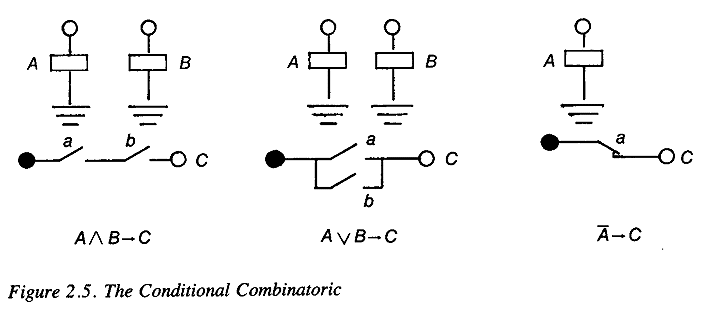
| Reckoners, Germany, page 0023 |
would be fulfilled (logically "true," numerically "one") when either A or B was true. The expression
would be fulfilled only when both A and B were true. The expression
would have the opposite value of A, whatever that was. The following expression yields the algebraic sign of the product of two numbers, assuming that the value "true" represents " + " and "false" represents "
The expression says that the sign (V) of the result (r) is positive for the operations of multiplication (m) or division (d), when either the signs of x and y are both positive or both negative. Note that the result of the operation appears at the right, and is indicated by the arrow formed by typing an equals sign and a greater-than sign. This convention indicates the dynamic aspect of what actually goes on in a machine, and is the opposite of the way mathematical functions are ordinarily written (with the function name at the left and an equals sign joining it to an expression on the right). Zuse's convention avoids confusing equality and the assignment of a value, a confusion that many modern programming languages exhibit. (There was an attempt to have a right-pointing assignment statement in the programming language ALGOL, but it was never adopted. This question will be discussed again in Chapter 6.)20
| Reckoners, Germany, page 0024 |
CONSTRUCTION OF THE FIRST COMPUTERS
| Reckoners, Germany, page 0025 |
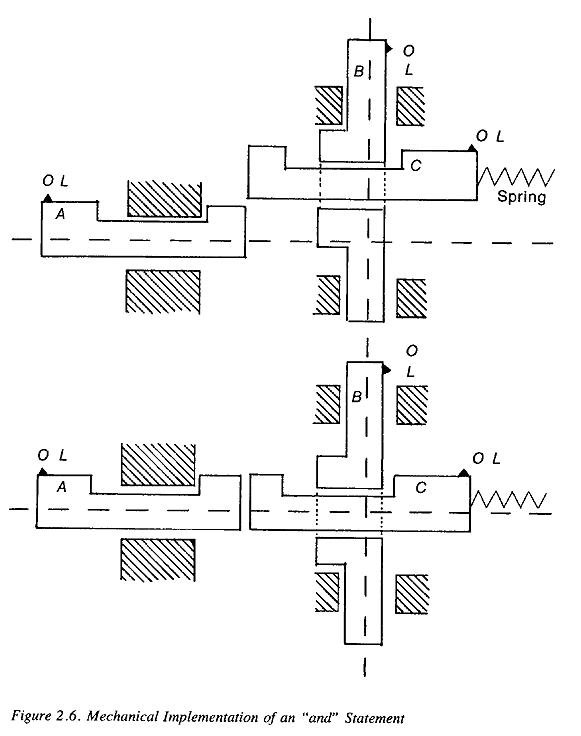
| Reckoners, Germany, page 0026 |
| Reckoners, Germany, page 0027 |
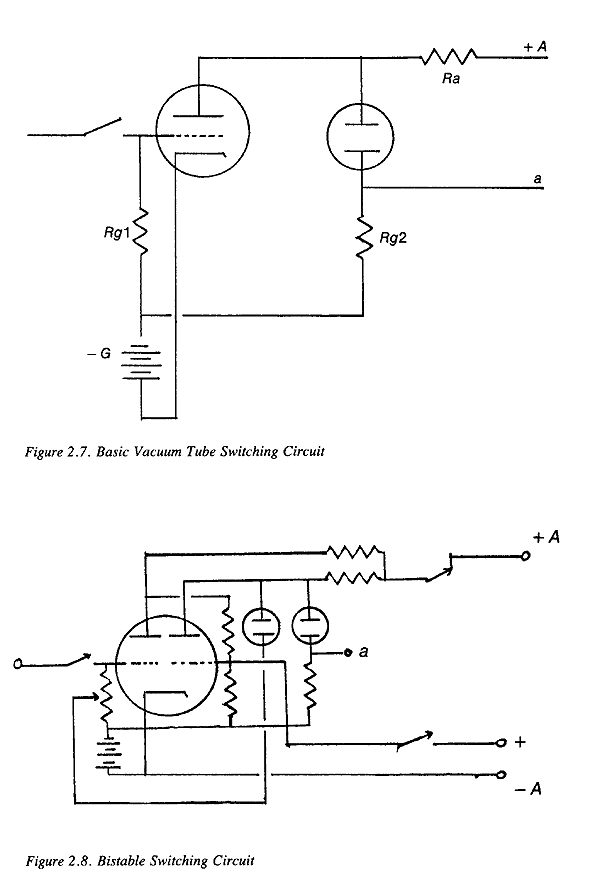
| Reckoners, Germany, page 0028 |
| Reckoners, Germany, page 0029 |
| Reckoners, Germany, page 0030 |
DESCRIPTION OF THE Z3
| Reckoners, Germany, page 0031 |
A DETAILED LOOK AT THE Z3
| Reckoners, Germany, page 0032 |
| Reckoners, Germany, page 0033 |
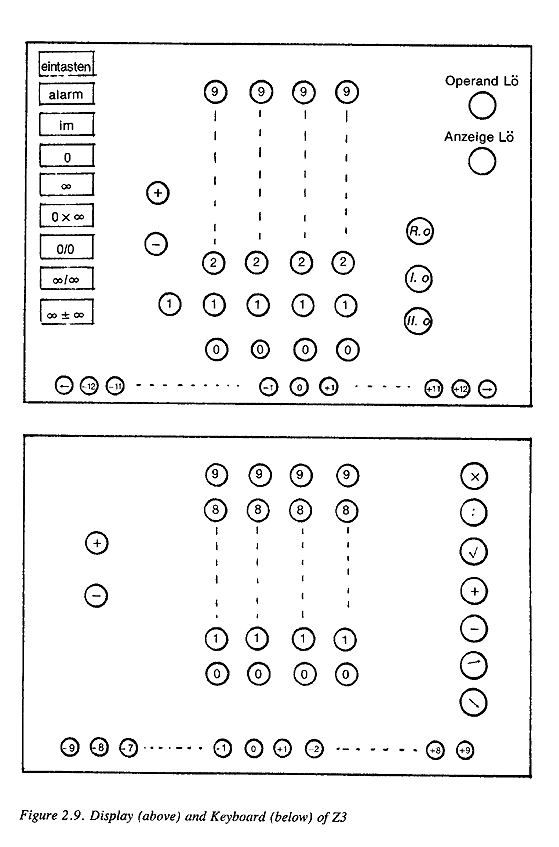
| Reckoners, Germany, page 0034 |
L O O L
L L L O
Table 2.1 summarizes the specifications of the Z3.
Table 2.1. THE Z3
Technology: electromagnetic relays: 2600 binary: memory 1400 arithmetic 600 misc. 600 20 step switches Number System: floating-point binary word length: 22 binary digits: sign 1 bit exponent 7 bits mantissa 14 bits Memory Capacity: 64 numbers random access Input/Output: push-button keyboard, display by incandescent bulbs, one for each decimal digit Programming: eight-channel perforated filmstrip, basic commands of + , - , x , - , square root, shift binary or decimal point "zero-addressing" (see text)
| Reckoners, Germany, page 0035 |
In floating-point binary the first digit of the mantissa is always "1" (just as in floating-point decimal the first digit is never zero), so that "1" was not stored. The decimal number 398, for example, would be stored as:
398 = 110,001,110 in binary
= 1.1000111 x 101000 in floating-point binary
or, using Zuse's notation:
000L000 L L000LLL0000000
------- ^ -----------------
exponent | mantissa (with leading L dropped)
sign digit (+ )
Representing numbers by floating-point binary in the Z3 was its most
interesting feature; it was something no other functional computer would have for
years. As an engineer, Konrad Zuse recognized from the start that such a representation
was better suited to the kinds of problems he faced, but to get a machine to handle
numbers that way was not a simple task. Floating-point arithmetic has an additional effect
of making the operation of addition slower (since the exponent has to be adjusted before
the mantissae can be added to each other), while it makes multiplication a little faster
(since one obtains the exponent of a product simply by adding the exponents of the two
operands). In engineering calculations, multiplication occurs more frequently than it
does in business or accounting work, so on the whole the Z3 was a more balanced machine given
the kind of work it was designed to do.
PROGRAMMING THE Z3
| Reckoners, Germany, page 0036 |
| a b c |
| d e f |
| g h i |
the determinant is given by the following formula:
To evaluate that expression using only pencil, paper, and slide rule, a person would perform the multiplications, additions, and subtractions as they appear in the formula above, writing down intermediate results along the way. (It is also possible to rearrange the expression slightly to minimize the number of intermediate results that has to be recorded.)
| Reckoners, Germany, page 0037 |
The Z3 was fully functional. For a series of different calculations there were program tapes available, for example for systems of linear equations. One could key in the coefficients, and the results were displayed. From my recollection it ran without error.41
| Reckoners, Germany, page 0038 |
| Reckoners, Germany, page 0039 |
| Reckoners, Germany, page 0040 |
NOTES
- Konrad Zuse, Der Computer, Mein Lebenswerk (Munich: Verlag Moderne
Industrie, 1970) p. 68.
- Zuse, Der Computer, pp. 15-16; C. Evans, interview with Zuse, "Pioneers of Computing Series" (London: Science Museum, 1976).
- Notebook 17, Zuse Archives, Gesellschaft fur Mathematik and Datenverarbeitung, Bonn.
- Konrad Zuse, interview with the author, April, 1978.
- Wilfred de Beauclair, Rechnen mit Maschinen (Braunschweig: Vieweg, 1968), p. 2.
- For a discussion of the symbolic analysis of Zuse's graphical scheme, see F. L. Bauer, Between Zuse and Rutishauser-the Early Development of Digital Computing in Central Europe, Technical University, Munich, Department of Informatics, Report 7629 (Munich, 1976).
- Zuse, Der Computer, pp. 36-39.
- Charles Babbage, "Passages from the Life of a Philosopher," in Charles Babbage and His Calculating Machines, ed. Philip and Emily Morrison (New York: Dover, 1961), p. 55.
- N. Metropolis and J. Worlton, "A Trilogy on Errors in the History of Computing," Annals of the History of Computing, 2 (1980): 49-59.
- De Beauclair, Rechnen mit Maschinen, pp. 11-15; W. Meyer zur Capellan, Mathematische Instrumente, 2nd ed. (Leipzig, 1949), pp. 53-55; Friedrich A. Willars, Mathematische Instrumente (Berlin, 1926), pp. 28, 48-51.
- Anton Glaser, History of Binary and Other Nondecimal Numeration (Southhampton, Pa., 1971); Hans J. Zacher, Die Hauptschriften der Dyadik von G. W. Leibniz, ein Beitrag zur Geschichte des Binaeren Zahlensystems (Frankfurt am Main, 1973), pp. 18-34; "Hewn von Leibniz' Rechnung mit Null and Eins," transcription of MS, 1679 (Munich: Siemens A. G., 1966).
- Quoted in Karl-Heinz Czauderna, "Konrad Zuse-der Weg zu seinem Computer Z3 and dessen Verwircklichung," Report 120, Gesellschaft fur Mathematik and Datenverarbeitung (Bonn, 1979), pp. 88-89.
Reckoners, Germany, page 0041
- Konrad Zuse, "Method for Automatic Execution of Calculations with the Aid of Computers," German Patent Application Z 23 139 IX/42m, April 11, 1936, reprinted in Brian Randell, ed., The Origins of Digital Computers: Selected Papers, 2nd ed. (New York: Springer Verlag, 1973), pp. 159-166.
- Czaudema, "Konrad Zuse," pp. 85-89.
- Ibid., pp. 31-40.
- Ibid., p. 89.
- E. Jessen, "Konrad Zuse-Konstructeur der ersten programmgesteuerten Rechenanlage," paper presented at the Advanced Course on General Net Theory of Processes and Systems, Hamburg, Oct. 10, 1979.
- Zuse, Der Computer, pp. 75-76; also Zuse Archiv, Bonn, # 009/002.
- Zuse, Der Computer, pp. 53, 64.
- F. L. Bauer, Between Zuse and Rutishauser, p. 36; see also the discussion by Bauer on the history of ALGOL, Association for Computing Machinery (ACM) SIGPLAN Notices 13, no. 8 (August, 1978), p. 40.
- Morris Kline, Mathematical Thought from Ancient to Modern Times (New York: Oxford, 1972), chapter 51; Jean van Heijenoort, From Frege to Godel: A Source Book in Mathematical Logic (Cambridge, Mass.: Harvard, 1967), introduction.
- Zuse, interview with the author, April, 1978.
- Konrad Zuse, "Ober Programmgesteuerte Rechenanlage fur industrielle Verwendung," Probleme der Entwicklung programmgesteuerte Rechengerdte and Integrieranlage, ed. H. Cremer (Aachen, 1953), p. 74; Konrad Zuse, "Die ersten programmgesteuerten Relaisrechenmaschine," 350 Jahre Rechenmaschine, ed. M. Graef (Munich, 1973), p. 55.
- Helmut Schreyer, "Die Entwicklung des Versuchsmodells einer elektronischen Rechenmaschine," unpublished, Mosbach/Baden, Aug. 1, 1977.
- Helmut Schreyer, "Das Rohrenrelais and seine Schaltungstechnik," dissertation, Technische Hochschule, Berlin, August, 1941.
- Ibid., p. 77.
- Records of party membership were obtained through the Berlin Document Center, Mission of the United States.
- Schreyer's letter has been translated and published in Brian Randell, Origins, pp. 167-169.
- Alfred Teichmann, "Das Flattern von Trag- and Leitwerken," Deutsche Akademie der Luftfahrtforschung, Schriften 49 (1941); Zuse, interview with the author, April, 1978.
- A letter from the DVL to Zuse, April 22, 1942, Zuse Archiv No. 014/008, states that the "provisory" machine (that is, the Z3) was completed by December 5, 1941.
- German Patent Application Z-391, applied for in 1941, rejected May 7, 1956; letter from de Beauclair to Czauderna, in Czaudema, "Konrad Zuse," p. 98; letter from Dreyer to the author, July 23, 1978; letter from Zuse, Zuse Archiv, No. 014/001.
- Zuse, Der Computer, p. 82; correspondence between Zuse and DVL, Zuse Archiv, No. 014/008; interview with Zuse by Uta Merzbach, Zuse Archiv, No. 030/002.
- Czaudema, "Konrad Zuse," pp. 70-73; Wend Goldbach and Rolf Schneider, "Beschreibung der Rechenanlage Z3," Zuse Forum, 2 (September, 1963), 19-31.
- H. Flessner, private communication, October 10, 1979.
- See, for example, John Ball, Algorithms for RPN Calculators (New York: Wiley, 1978), p. 163; Donald E. Knuth, Seminumerical Algorithms (Reading, Mass.: Addison Wesley, 1969), pp. 192-193, 205.
Reckoners, Germany, page 0042
- Ball, Algorithms, chapter 1; John Kennedy, "RPN History," paper presented at the Western Calculator Conference, Anaheim, Calif., Sept. 22, 1979.
- Zuse, Der Computer, pp. 83-84, 93-94; Zuse Archiv, No. 017/013.
- H. G. Kussner, "Flugelschwingungen an Flugzeugen," Zeitschrift fur Angewandte Mathematik and Mechanik, 9 (1929), 492-493; H. G. Kussner, "Zusammenfassender Bericht uber den instationaren Auftrieb," Luftfahrtforschung, 13 (1936), 410-429.
- Alfred Teichmann, "Das Flattern"; letter from DVL to Zuse, May 6, 1943, Zuse Archiv, No. 028/008; Konrad Zuse, "Some Remarks on the History of Computing in Germany," paper presented at the Conference on the History of Computing, Los Alamos, New Mexico, 1976; C. Evans, interview with Zuse, "Pioneers of Computing" series.
- Letter from de Beauclair to Czaudema, in Czauderna, "Konrad Zuse," p. 98.
- Letter from Dreyer to the author, July 23, 1978.
- Interrogation summary of Gerhard Overhoff by U.S. Forces in Austria, Air Interrogation Unit, 8 Nov., 1946, p. 1; correspondence in Zuse Archiv, Nos. 028/009 and 036/012.
- Rowland F. Pocock, German Guided Missiles of the Second World War (New York: Arco, 1967), pp. 33, 44-45.
- Zuse, Der Computer, pp. 87-90, 97, 106; correspondence in the Zuse Archiv, Nos. 002/004, 014/001, 017/009.
- R. C. Lyndon, "The Zuse Computer," Mathematical Tables and Other Aids to Computation, 2 (1947), 355-359; "Applied Mathematical Research in Germany, with Particular Reference to Naval Applications," British Intelligence Objectives Subcommittee (BIOS), Report No. 79, pp. 63-64; "The Development of Theoretical and Applied Mechanics in German Institutions During the War," Great Britain, Field Information Agency, Technical (FIAT), Final Report No. 1167, 1947.
- F. L. Bauer and H. Wossner, "The Plankalkhl of Konrad Zuse: A Forerunner of Today's Programming Languages," Communications ACM, 15 (1972), 678-685; Donald E. Knuth and L. T. Pardo, "The Early Development of Programming Languages," Encyclopedia of Computer Science and Technology, ed. Jack Belzer, vol. 7 (New York: Dekker, 1977).
- See, for example, Konrad Zuse, "The Emancipation of Data Processing," paper presented at the Advanced Course on General Net Theory of Processes and Systems, Hamburg, October, 1979.
- Zuse, Der Computer, pp. 15-16; C. Evans, interview with Zuse, "Pioneers of Computing Series" (London: Science Museum, 1976).
